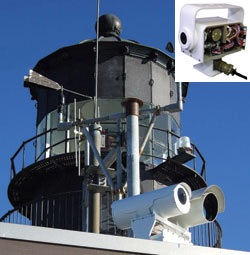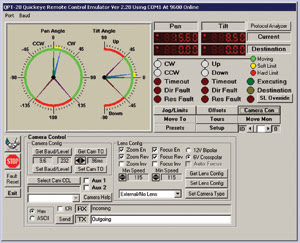Frank Perry and Dan A. Cloud, QuickSet International Inc.
The challenge of securing national borders, ports and harbors is increasingly dependent on stabilized, long-range, automated electro-optic surveillance systems. The demand for durable high-resolution electro-optic cameras has skyrocketed, and as a result, the requirements for azimuth and elevation positioning platforms, mounting single-spectrum or multispectral imagers, have become equally robust and demanding.
In the past three years, the performance of pan-and-tilt systems has evolved along with electro-optic systems. Although the architectural configuration of video security and surveillance systems has not changed much, the performance specifications for target detection and identification have increased. Typical commercial systems, for example, are wholly inadequate for homeland security. The desire for better range, repeatability and automatic repositioning, among other features, has created a demand for greater platform payload capacity, stability, accuracy, endurance and dynamic performance.
Besides structural improvements, the integrated system-level performance developed for homeland security required functional changes in modern pan-and-tilt systems. And now, so-called “smart” platforms are available.

Figure 1. The US Coast Guard uses the smart sensor node for maritime surveillance at Cape Disappointment, Wash. The inset shows the pan-and-tilt system’s onboard processor. Images courtesy of QuickSet International Inc.
The smart pan-and-tilt system embeds specific electronic and processor power at the platform to simplify communications, wiring and command complexity for large, dispersed surveillance systems employing hundreds of imaging nodes. Communication between the command center and each node is achieved through standard serial interfaces or Ethernet/IP addressability. The node itself can interpret imager command formats to multiple mounted devices, simultaneously allowing plug-and-play capability at the node level. Functions such as aperture, contrast, zoom and focus are all controllable through the pan-and-tilt system.
Before the smart platform, cameras typically were connected to an external controller that required separate conductors to each motor and position sensor of the pan-and-tilt system and camera lenses. Additional conductors provided power and, where applicable, serial control for the cameras. Advancements in microcontroller and motor driver design have made it possible for the circuitry — which once occupied a separate box — to be housed inside the pan-and-tilt system, simplifying system integration and cabling requirements.
Running a smart platform
In a typical smart system, power, serial communication and video connections are all that are required. AC or DC power (depending on site availability) to the pan-and-tilt system may be rectified or regulated and supplied to the camera. Motor drivers for zoom and focus are integrated into the circuitry, which has provisions for lens-position feedback. This allows pan, tilt, zoom and focus to be activated using appropriate serial commands, and allows the zoom and focus attributes to be included in preset positions stored in the pan-and-tilt system’s nonvolatile RAM. During execution of a preset move, the servo loop is contained between the pan-and-tilt system position sensors, the zoom and focus potentiometers, and the processing electronics integrated into the pan-and-tilt system.
The system’s onboard processor also interprets and executes all azimuth/elevation pointing commands within the node. Its serial protocol accommodates open-loop jog commands (go left, right, up or down; zoom in or out; focus near or far; or combinations of these, at variable speeds) as well as automated moves such as “move to Preset 1” or “move incrementally 10° to the right.” Serial commands are interpreted in terms of pan/tilt speeds, and absolute or relative pointing locations.
Dozens of preset locations can be stored within the node memory; alternatively, the command center can provide discrete pointing instructions either through automated processes or with a human in the loop. Along with programmable presets, settings such as zoom and focus are stored relative to each predetermined location of interest. This allows the system operator to initiate sensor-coordinated, programmed or random tours for imaging predefined locations within the surveilled area. These automated and simplified command instructions enable quick initiation of complex operations.

Figure 2. Software allows programming of the smart nodes for preset and tour routines, including all pan-and-tilt system and camera settings for each location of interest.
Another smart feature embedded in the pan-and-tilt system is the ability to “translate” pointing commands from legacy security control stations. Many current-generation systems are upgrades of previous ones. In other cases, existing systems may be expanded using contemporary smart pan-and-tilt systems that may respond to legacy controllers through protocol translation. In these cases, the system can translate the command protocol from the older one. In newer, more robust surveillance systems, the smart nodes provide additional bidirectional-state information — such as absolute pointing location and diagnostics — that was not contemplated in older versions. Newer, integrated systems are designed for harsher environments such as military, mobile and marine environments, where shock, vibration and causticity are expected.
Electronics, large-scale integration and distributed processing have advanced many of the technologies used in security and surveillance applications, yet positioning of sensors, imagers and antennas is often still performed by a brute-force electromechanical process. By integrating the pan-and-tilt system platform with distributed electronic-processing capability, the overall design is becoming much simpler and, at the same time, far more capable.
Meet the authors
Frank Perry is executive vice president and Dan A. Cloud is technical director of business development at QuickSet International Inc. in Northbrook, Ill.; e-mail: [email protected].